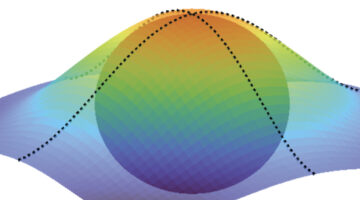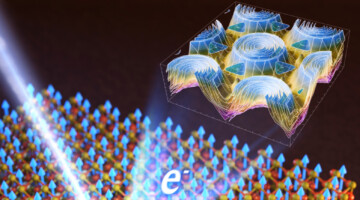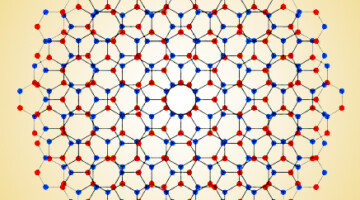In a study of twisted bilayer graphene (TBG) systems, researchers found intriguing spectroscopic features in a superconducting “magic-angle” TBG—features that are absent in non-superconducting TBG. The results provide crucial information on superconductivity in magic-angle TBG for next-gen electronics and advanced energy technologies. Read more »![]()
ALS Work Using ARPES
Angle-resolved photoemission spectroscopy (ARPES) is a technique in which a highly focused beam of x-rays is used to kick electrons out of the sample. By analyzing the ejected electrons' direction and energy, the researchers can obtain the material's band structure—a map of the electrons' behavior in the material.
Mapping the Quantum Landscape of Electrons in Solids
Researchers found a way to reconstruct quantum geometric tensors (QGTs)—mathematical entities that encode how an electron’s wave function is shaped by its quantum environment. The mapping of QGTs enables the discovery and control of novel quantum phenomena such as superconductivity and unconventional electronic phases. Read more »![]()
![]()
Hide-and-Seek with Sneaky Electrons in Solids
Researchers used angle-resolved photoemission spectroscopy (ARPES) at the Advanced Light Source (ALS) to demonstrate the existence of dark—state electrons in solids for the first time, providing insights into complex phenomena in physics, such as high-temperature superconductivity and optoelectronics.
Read more »
Not All Gaps Are Created Equal
Researchers found that charge density waves (CDWs) in topological materials induce unconventional spectral gaps in the materials’ electronic structure. The finding that CDWs in topological materials can be essentially different from those in other materials should be carefully considered when designing quantum devices. Read more »![]()
Lattice-Dependent Spin Textures in High-Tc Superconductors
Researchers found that in bismuth-based cuprate superconductors, charge imbalances caused by lattice distortions generate persistent and universal patterns of spin polarization. The results supply a previously missing but essential ingredient in efforts to understand the mechanisms driving the electronic behavior of high-temperature superconductors. Read more »![]()
![]()
Tuning the Spin Transition and Carrier Type in Rare-Earth Cobaltates via Compositional Complexity
This work demonstrates that tunable disorder in a crystal can be quite useful: compositional site disorder was used to modify oxide semiconductors by changing the carrier type, improving crystallinity and tuning a spin transition. Applications include electrothermal thresholding devices such as radio frequency limiters. Read more »
Strategic ALS Projects Reach Key Milestones
Thanks to the hard work and dedication of multidisciplinary teams from groups across the ALS, a spate of important milestones occurred over the past month, for projects involving the new QERLIN beamline, the MERLIN beamline upgrade, and a new chamber for computer-chip metrology in Sector 12. Read more »
Stabilizing Pristine α-Sn Thin Films for Topological Investigation
Researchers developed a recipe for the room-temperature stabilization of thin films of α-Sn, a form of elemental tin that exhibits a variety of topologically nontrivial phases, but only at low temperatures. By dramatically reducing contamination from the film’s substrate, the recipe greatly simplifies electronic structure studies. Read more »![]()
Room-Temperature 2D Magnet: Electronic-Structure Insights
Researchers found that small changes in how electron spins interact with each other can make a big difference in the magnetic transition temperatures of 2D magnets. Understanding such factors can help create better magnetic materials for information storage, sensors, medical imaging, and energy-efficient computing. Read more »![]()
![]()
Big Twist Leads to Tunable Energy Gaps in a Bilayer Stack
Researchers found that twisting 2D layers at atypically large angles opens up potentially useful energy gaps in the material’s band structure. The results suggest a new way to tune materials for optoelectronic applications and provide a platform for exploring novel “moiré” phenomena beyond those observed at small twist angles. Read more »![]()
![]()
- 1
- 2
- 3
- …
- 7
- Next Page »









